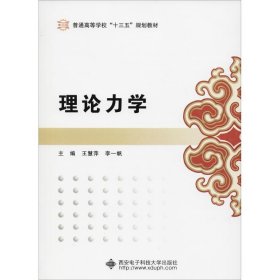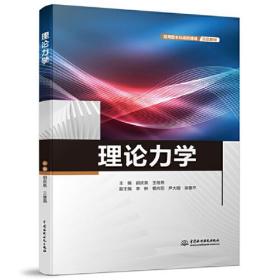
理论力学
全新正版 极速发货
¥ 55.3 6.2折 ¥ 89 全新
库存6件
广东广州
认证卖家担保交易快速发货售后保障
作者易平,刘君,姜峰
出版社科学出版社
ISBN9787030737625
出版时间2023-11
装帧平装
开本其他
定价89元
货号1203114062
上书时间2024-06-03
- 最新上架
商品详情
- 品相描述:全新
- 商品描述
-
目录
Foreword
Chapter 1 Introduction 1
1.1 Mechanics 1
1.2 Fundamental Concepts and Principles 2
1.2.1 Fundamental Concepts 2
1.2.2 Newton’s Laws of Motion 2
1.2.3 Newton’s Law of Gravitational Attraction 3
1.3 Units of Measurement 4
1.4 Procedure of Problem Solving 5
Problems 7
Chapter 2 Vectors and Vector Operations 9
2.1 Vectors and the Parallelogram Law 9
2.2 Cartesian Vectors 11
2.2.1 Cartesian Vector Representation 12
2.2.2 Addition and Subtraction of Cartesian Vectors 15
2.3 Vector Directed Along a Line 16
2.4 Dot Product and Cross Product 19
2.4.1 Cartesian Vector Formulation of the Dot Product 19
2.4.2 Applications of the Dot Product 20
2.4.3 Cartesian Vector Formulation of the Cross Product 22
Problems 23
Chapter 3 Simplification of Force Systems 27
3.1 Moment of a Force About a Point 27
3.1.1 Vector Formulation 28
3.1.2 Principle of Moments 31
3.1.3 Scalar Formulation 32
3.2 Moment of a Force About a Specified Axis 35
3.3 Moment of a Couple 39
3.3.1 Vector Formulation 39
3.3.2 Scalar Formulation 41
3.4 Simplification of a System of Forces and Couples 43
3.4.1 Equivalent System 43
3.4.2 Reduction to One Force and One Couple 45
3.4.3 Further Simplification 48
3.5 Application of Simplification of Parallel Forces 53
3.5.1 Center of Gravity, Center of Mass, and Centroid of a Body 53
3.5.2 Center of Gravity, Center of Mass, and Centroid of Composite Bodies 60
3.5.3 Reduction of Distributed Loading 62
Problems 67
Chapter 4 Equilibrium of Rigid Bodies 74
4.1 Conditions for Rigid-Body Equilibrium 74
4.2 Free-Body Diagrams 76
4.2.1 Support Reactions 77
4.2.2 Procedure of Drawing a Free-Body Diagram 79
4.3 Equilibrium Problems of a Rigid Body 84
4.4 Two-and Three-Force Members 90
4.5 Constrains and Statical Determinacy 91
4.6 Equilibrium Problems of Structures 94
4.7 Simple Trusses 101
4.7.1 The Method of Joints 103
4.7.2 Zero-Force Members 106
4.7.3 The Method of Sections 107
Problems 110
Chapter 5 Friction 120
5.1 Characteristics of Friction 120
5.1.1 Laws of Sliding Friction 121
5.1.2 Angles of Friction and Self-Locking 123
5.2 Problems Involving Sliding Friction 124
5.3 Rolling Resistance 129
Problems 132
Chapter 6 Kinematics of Particles 138
6.1 General Curvilinear Motion 139
6.2 Curvilinear Motion: Rectangular Components 140
6.3 Curvilinear Motion: Tangential and Normal Components 146
6.3.1 The t-n-b Coordinate System 146
6.3.2 Velocity 147
6.3.3 Acceleration 148
6.4 Absolute Dependent Motion Analysis of Particles 154
6.5 Relative-Motion Analysis Using Translating Axes 158
Problems 162
Chapter 7 Planar Kinematics of Rigid Bodies 168
7.1 Translation 169
7.2 Rotation about a Fixed Axis 170
7.2.1 Angular Motion 171
7.2.2 Motion of a Particle on a Rotating Body 172
7.3 Absolute Dependent Motion Analysis of Bodies 179
7.4 General Plane Motion 181
7.4.1 Relative-Motion Analysis: Velocity and Acceleration 182
7.4.2 Instantaneous Center of Rotation 191
Problems 198
Chapter 8 Kinetics: Equations of Motion 205
8.1 Newton’s Second Law of Motion 205
8.2 Equation of Motion for a Particle 206
8.3 Equation of Motion for a System of Particles 216
8.4 Mass Moment of Inertia 217
8.4.1 Parallel-Axis Theorem and Radius of Gyration 220
8.4.2 Mass Moment of Inertia of Composite Bodies 221
8.5 Planar Kinetic Equations of Motion 224
8.5.1 Equations of Motion for Translation 227
8.5.2 Equations of Motion for Rotation about a Fixed Axis 231
8.5.3 Equations of Motion for General Plane Motion 235
Problems 239
Chapter 9 Kinetics: Work and Energy 247
9.1 Work and Power 247
9.1.1 Work 247
9.1.2 Power 254
9.2 Kinetic Energy 256
9.2.1 Kinetic Energy of a Particle 256
9.2.2 Kinetic Energy of a System of Particles 256
9.2.3 Kinetic Energy of a Rigid Body in Planar Motion 257
9.3 Principle of Work and Energy 260
9.3.1 Principle of Work and Energy for a Particle 260
9.3.2 Principle of Work and Energy for a System of Particles 264
9.4 Conservative Forces and Conservation of Energy 272
9.4.1 Conservative Forces 272
9.4.2 Potential Energy 273
9.4.3 Principle of Conservation of Energy 274
Problems 278
Chapter 10 Kinetics: Impulse and Momentum 285
10.1 Principle of Linear Impulse and Momentum for a Particle 285
10.1.1 Linear Momentum and Linear Impulse 285
10.1.2 Principle of Linear Impulse and Momentum 286
10.2 Principle of Angular Impulse and Momentum for a Particle 290
10.2.1 Angular Momentum 290
10.2.2 Principle of Angular Impulse and Momentum 292
10.3 Principle of Impulse and Momentum for a System of Particles 294
10.3.1 Linear Momentum of a System of Particles 295
10.3.2 Angular Momentum of a System of Particles 296
10.3.3 Angular Momentum of Rigid Bodies in Planar Motion 297
10.3.4 Principle of Impulse and Momentum for Rigid Bodies in Planar Motion 300
10.4 Principle of Conservation of Momentum 308
Problems 313
Answers 318
References 328
内容摘要
首先学生们是学过高中物理和大学物理的力学篇才来学理论力学的,因此本教材应弱化和物理中重复的理论部分,如平面汇交力系、点的直线运动、刚体简单运动和质点运动微分方程等。另外,将本属于材料力学的内容删除,也将国内高校理论力学课程教学要求不涉及的刚体定点运动和刚体任意运动的内容删除,确保英文教材内容符合国家教委制定的"理论力学课程教学基本要求"。遵循一般国内理论力学教材的内容体系,含理论力学的静力学、运动学和动力学三大篇的基本部分和虚位移原理。
相关推荐
— 没有更多了 —





















以下为对购买帮助不大的评价